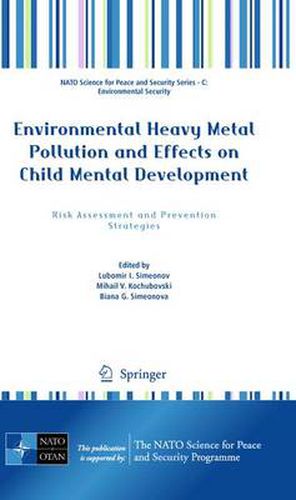Readings Newsletter
Become a Readings Member to make your shopping experience even easier.
Sign in or sign up for free!
You’re not far away from qualifying for FREE standard shipping within Australia
You’ve qualified for FREE standard shipping within Australia
The cart is loading…






This title is printed to order. This book may have been self-published. If so, we cannot guarantee the quality of the content. In the main most books will have gone through the editing process however some may not. We therefore suggest that you be aware of this before ordering this book. If in doubt check either the author or publisher’s details as we are unable to accept any returns unless they are faulty. Please contact us if you have any questions.
Heavy metals can be emitted into environment by both natural and anthropogenic sources, mainly mining and industrial activity. Human exposure occurs through all environmental media. Infants are more susceptible to the adverse effects of exposure. Increasing attention is now being paid to the mental development of children exposed to heavy metals. The purpose of this book is to evaluate the existing knowledge on intellectual impairment in children exposed to heavy metals in their living environment and to identify the research needs in order to obtain a clearer picture of the situation in countries and regions at risk, in which the economy is closely related to metallurgy and heavy metals emission, and to recommend a strategy for human protection. In greater detail the main objectives could be formulated as follows: to review the principal sources of single, and complex mixtures of, heavy metal pollutants in the environment; to identify suitable methodology for chemical analyses in the environment and in humans; to evaluate the existing methods for measuring mental impairment, including their reliability and validity; to recommend a standard testing protocol to be used in future research; to assess the future role of environmental heavy metal pollution in countries and regions at risk and its effects on children’s neurological development; to recommend a prevention strategy for protecting children’s health and development.
$9.00 standard shipping within Australia
FREE standard shipping within Australia for orders over $100.00
Express & International shipping calculated at checkout
This title is printed to order. This book may have been self-published. If so, we cannot guarantee the quality of the content. In the main most books will have gone through the editing process however some may not. We therefore suggest that you be aware of this before ordering this book. If in doubt check either the author or publisher’s details as we are unable to accept any returns unless they are faulty. Please contact us if you have any questions.
Heavy metals can be emitted into environment by both natural and anthropogenic sources, mainly mining and industrial activity. Human exposure occurs through all environmental media. Infants are more susceptible to the adverse effects of exposure. Increasing attention is now being paid to the mental development of children exposed to heavy metals. The purpose of this book is to evaluate the existing knowledge on intellectual impairment in children exposed to heavy metals in their living environment and to identify the research needs in order to obtain a clearer picture of the situation in countries and regions at risk, in which the economy is closely related to metallurgy and heavy metals emission, and to recommend a strategy for human protection. In greater detail the main objectives could be formulated as follows: to review the principal sources of single, and complex mixtures of, heavy metal pollutants in the environment; to identify suitable methodology for chemical analyses in the environment and in humans; to evaluate the existing methods for measuring mental impairment, including their reliability and validity; to recommend a standard testing protocol to be used in future research; to assess the future role of environmental heavy metal pollution in countries and regions at risk and its effects on children’s neurological development; to recommend a prevention strategy for protecting children’s health and development.